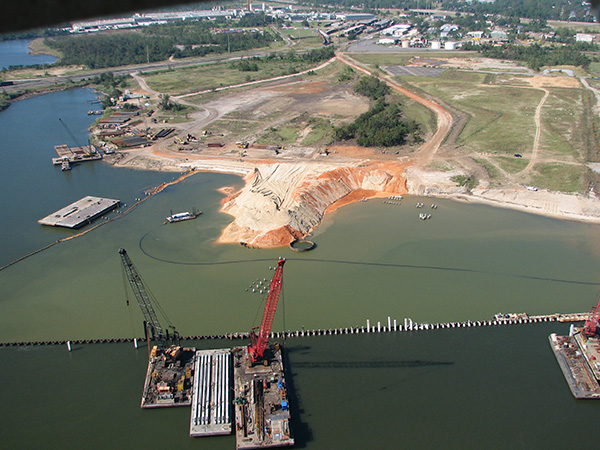GET was responsible for providing the soils explorations, geotechnical engineering evaluations and construction materials testing for the land reclamation and site stabilization for the 130-acre development of the Alabama State Port Authority Choctaw Point Container Terminal. The terminal project included 2000 feet of ship wharf/dock structure, 200 acres of paved container yard, a 100-acre intermodal container yard, APM Terminal Structures and project roads. The wharf/dock structure is supported on 24 and 30-inch pre-stressed concrete piles and a heavy pipe-z sheetpile bulkhead. The container yard area is constructed of heavy duty asphalt and roller compacted concrete (RCC) pavements.
The initial portion of the project was an extensive earthwork project with approximately 30 acres of the site development being reclaimed from adjacent waters. GET performed a compilation of past soil boring data (both marine and land) to reduce the project field exploration costs and optimize the locations of additional soil borings required for the project. Extensive laboratory analyses were required to support the engineering evaluations required to address design soil strength, consolidation parameters, settlement analyses associated with loading the compressible clay soils found within project limits and stability analyses with respect to filling over the bottom soils of the Mobile River. After the installation of the wharf/dock structures, fill soils and a preload were placed to develop the site. Wick drains were installed to reduce fill and preload settlement wait time. In addition to the wick drains, strip drains, stone columns, vibro-compaction of sand and placement of lightweight ash fill materials were all utilized in the filling and preparation of yard areas and dock structure. Approximately 1.5 million cubic yards of fill material was required to develop and stabilize the site. GET performed investigations of various offsite borrow sites to find the most economical borrow materials for the project.
The APM Terminal Facility included an Administration Building, Maintenance Building, Security/Customs Building, Inbound/Outbound Roads and Gate Structure, and Restroom Facilities. The heavier structures (Administration and Maintenance) are pile supported with spread foundations utilized for the balance of the structures.
In addition to the testing of soils and concrete utilized on the project, GET personnel monitored the installation of fill soils, wick drains, pile foundations and load tests performed during the construction of the site. GET also worked with the contractor to provide the quality control testing of the RCC pavements utilized for the first 80-acre phase of the container terminal.
Mobile, Alabama

